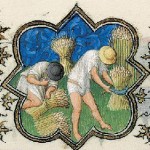 |
 |
 |
Above, from left to right: Calendar page for July from the Belles Heures of Jean de France, Duc de Berry, 1405???1408/1409. Pol, Jean, and Herman de Limbourg (Franco-Netherlandish, active in France, by 1399???1416). French; Made in Paris. The Metropolitan Museum of Art, New York, The Cloisters Collection, 1954 (54.1.1); detail of the activity for the month; detail of the zodiacal symbol Leo. See the Collection Database to learn more about this work of art.
???No tempest, good Julie,??? said Thomas Tusser. In Tusser???s sixteenth-century English, “July” rhymed with “truly”???as it did until the mid-eighteenth century. (The Oxford Companion to the Year, 1999). If the midsummer storms did not spoil the crops, the farmer could count himself lucky. (For charms against bad weather, see “Midsomer Magick,” June 23.)
The great event of the medieval summer was the harvest. A poor yield meant privation for the whole cycle of the year to come. By July the grain stores of the last harvest were depleted. In the great fourteenth-century poem Piers Plowman, Piers speaks of staving off hunger with a vegetable diet of parsley, leeks, and cabbages, supplemented with a little cream and some cheese, until the grain in his barn can be replenished at Lammas, the first of August. So great a blessing was an abundant harvest that the warmth and productivity of the season was interpreted as an allegory of spiritual plenty. The ninth-century theologian Hrabanus Maurus writes that summer sun expresses the heat of God???s love, and that the season signifies the blessedness to come in Heaven (Marie Collins and Virginia Davis, A Medieval Book of Seasons, 1992).
Once the hay had been taken in June (see “Making Hay,” June 5), the legumes and grains were harvested in July or August, depending on the locale. The labors depicted in Continental calendars as proper to July belong to August in Thomas Tusser’s poem Five Hundred Points of Good Husbandry.
Although all grain would eventually be stored, the amount of time the newly cut sheaves were left to stand in the fields to ripen and cure depended on the cereal. Rye (Secale cereale), barley (Hordeum vulgare), and wheat (Triticum sp.) all had their uses, and the straw could be cut and used as bedding, fodder, thatching, kindling, and more.
I’ve forsaken the city for a while, and am at my farm upstate; I’ll post again the week of 7/20. The hay has yet to be taken here; it’s been too rainy.
???Deirdre Larkin
Tags: barley, grain, harvest, hordeum vulgare, Hrabanus Maurus, July, legume, rye, secale cereale, Thomas Tusser, triticum sp., wheat
